Beekeepers battling varroa mite count the cost of failed eradication and call for industry exit strategy
/ By Bronwyn Herbert
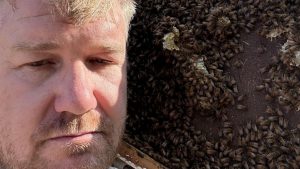
Jon Lockwood had to kill his own bees, pouring petrol on 2,500 hives.(Supplied: Jon Lockwood)
Search warrants have been issued as part of the federal government’s investigation into the suspected illegal importation of live bees infected with varroa mite, as the industry works out what’s next in learning to live with the deadly pest.
Key points:
- It’s now thought the pest did not arrive via Newcastle port as originally suspected
- More than 30,000 hives have been euthanased across 286 infested premises
- A beekeeper has called for an exit strategy for those looking to leave the industry
Varroa mite was first detected in sentinel hives at the Port of Newcastle in June 2022, but authorities now know ground zero was near Williamtown further north.
The investigation, known as Operation Decker, began as a result of information passed on by the NSW Department of Primary Industries (DPI).
“Our information that we’ve provided was intel on the ground as well as all the epidemiology data,” said NSW DPI director-general, Scott Hansen.
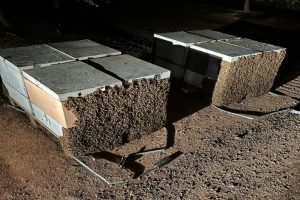
More than 30,000 hives have been destroyed as part of the eradication strategy.(Supplied: Jon Lockwood)
“It didn’t come into the Newcastle port in a natural channel that we would have assumed.
“We have our virology team currently looking at viruses that the mites are carrying, and trying to get genomic sequencing of those viruses that might give us an additional piece of information.”
A federal Department of Agriculture, Fisheries and Forestry spokesperson said the AFP and state law enforcement agencies were assisting and as it was an ongoing investigation, it would be inappropriate to comment further.
The maximum penalties for offences under the Biosecurity Act 2015 are up to 10 years imprisonment or $626,000 per offence.
Beekeeper forced to cull his own hives
Second-generation beekeeper Jon Lockwood from Goldfields Honey near Orange had 2,500 hives pollinating an almond farm near Balranald in the NSW Riverina region, when varroa was confirmed in a neighbouring orchard.
“Varroa mite wasn’t detected in our hives, but because our bees were trapped in the eradication zone they had to be euthanased,” he said.
His hives were some of the last killed under the eradication program and because of the sheer scale of his operation, he was pouring petrol on his own bees.
“Because it was such a large amount, the DPI didn’t have the manpower to come in and euthanise the hives themselves,” he said.
“The almond orchard owner needed to spray insecticides, so we had to send our own team to euthanise the bee hives.
“That’s one of the hardest things I’ve ever had to do.”
Kempsey beekeeper Derek Seam was also caught up in the Riverina incursion.
The third-generation apiarist’s bees tested negative through mandatory alcohol-wash testing, so trucked his 1,000 hives to almond orchards in the Riverina, 1,000 kilometres away.
Mr Seam spent a decade building up his hives to a commercial scale, battling fires, floods and droughts, as pollination was a chance to earn decent money.
However, within weeks of moving his hives to an orchard near Balranald, he found out varroa had been detected on a property there within 3km of his bees, which meant under the eradication order he would have to have all his hives destroyed.
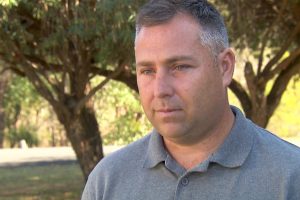
Derek Seam wants to know how varroa mite came into Australia.(ABC: Paul Ree)
“I had no idea of the scale that it would have ended that way,” he said.
“It’s just devastating for our family.
“I work closely with my dad and my brother, we are all in the same area, the same situation and we are all wiped out unfortunately.”
Across the Kempsey region more than 50 properties have tested positive for the mite.
Mite on the move
The DPI, has led the response to the pest as part of the varroa mite national management group, which includes input from 16 pollination-dependent industries.
It has defended the time taken to transition from eradication to management.
The varroa mite eradication strategy was abandoned in September.
More than $101 million has been spent across the response, with NSW spending $57.5 million.
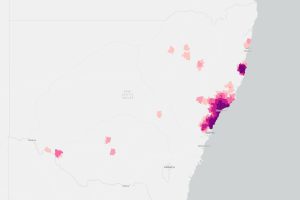
A weekly updated heat map tracks the known spread of Varroa.(Supplied: NSW DPI)
“Unfortunately as it turned out with Newcastle, we know now it arrived 12 to 18 months before it became obvious and apparent to government and the industry parties that it was there,” the DPI’s director-general, Mr Hansen, said.
“With Kempsey, it was there at least eight months before we were able to bring our response to bear.
“Those time lags really are an impediment to an effective eradication response.”
NSW is home to 45 per cent of Australia’s beekeepers, but according to Mr Hansen, there was patchy industry compliance with varroa testing.
“We had less than half of the registered beekeepers undertaking the alcohol washes in the time frame required — that’s a significant disadvantage to any eradication program,” he said.
A DPI spokesperson said in terms of compliance, 35 investigations remained open, 23 penalty notices had been enforced and five warning letters had been issued.
Beekeeper calls for exit packages
Goldfields Honey’s managing director, Mr Lockwood, said there was a lot of uncertainty across the industry, as apiarists waited for varroa to move through the landscape, all while battling low prices due to a sharp increase in imported honey.
“There’s a lot of old guys out there,” he said.
“It is going to take a good decade to learn to manage varroa and anyone that is currently not making a dollar, they won’t be viable because are going to have massive input costs.”
Industry data estimates a third of commercial beekeepers will leave the field, with a reduction of up to 60 per cent among hobbyists and semi-commercial operators.
Mr Lockwood said there was a lot at stake.
“Beekeepers need to make a decision very quickly while their beehives are healthy and not riddled with varroa,” he said.
“They need to decide whether they are in or out, and whether they can afford to keep going with varroa in their business.”
Mr Lockwood said varroa mites could breed in massive numbers, creating “mite bombs” that could then affect other beekeeping operations.
“A strategy needs to be developed for those beekeepers to exit the industry while they still have something to sell,” he said.
He is calling for financial incentives from government to help beekeepers leave the industry before it gets too difficult to manage the pest.
Beekeepers can bounce back
Experts predict varroa will spread across Australia within three years, except for Western Australia, Tasmania and the Northern Territory.
While native stingless bees will be spared, the number of feral bees is expected to be reduced by 95 per cent.
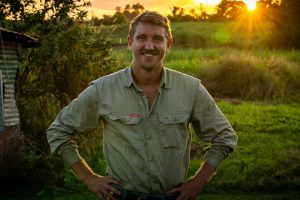
Cooper Schouten said the price paid for pollination in NZ increased by 30 to 100 per cent when varroa spread.(ABC: Cam Lang)
Southern Cross University Researcher Cooper Schouten said despite the destruction, for those who could manage the pest it could provide an opportunity.
“When we lose those feral honey bees from the environment, growers will likely need to pay for more hives to get the same pollination service,” Dr Schouten said.
“It’s going to really increase the demand for pollination services at a time when beekeepers are finding it even harder to keep their bees alive.”
A 2014 study of the economic contribution of all managed and wild honey bee pollinators, including honey and bee products, totalled $14 billion annually.
“It’s not the end of the industry, there’s lots of beekeepers out there that have viable businesses, and Australia will remain that way as well,” Dr Schouten said.
We are here to share current happenings in the bee industry. Bee Culture gathers and shares articles published by outside sources. For more information about this specific article, please visit the original publish source: Beekeepers battling varroa mite count the cost of failed eradication and call for industry exit strategy – ABC News








